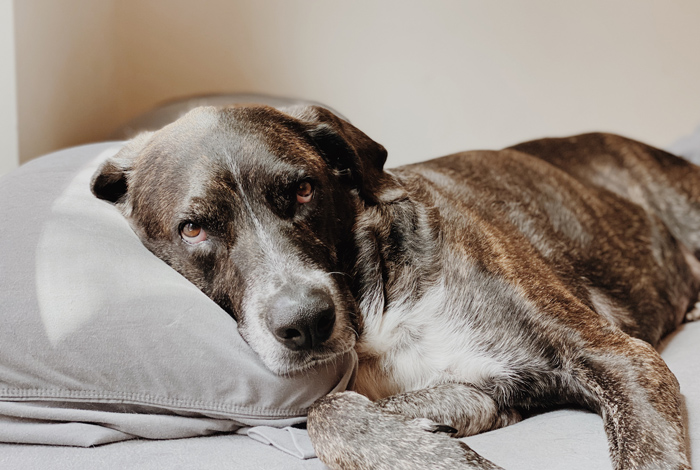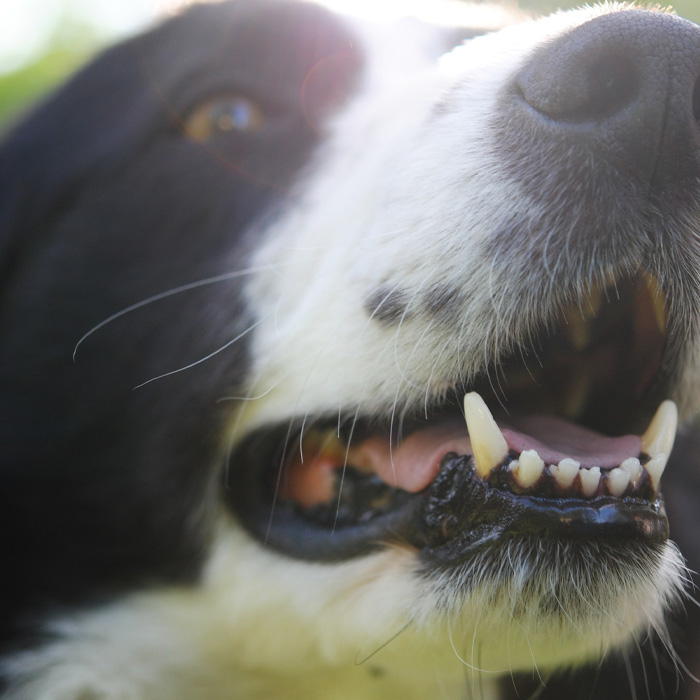Knowing a dog’s age is key to giving them the right care and understanding their health needs. To guess a dog’s age, experts look at signs like tooth wear, coat graying, and eye clarity—also considering changes in how they move and their energy levels. For mixed breeds, advanced methods like DNA testing can be really helpful. This information is crucial for choosing the right food, exercise, and medical care for the dog’s stage in life.
- Tooth wear, coat graying, and eye clarity help estimate a dog's age.
- Tooth wear, coat graying, and eye clarity help estimate a dog's age.
- Advanced age detection in dogs can involve DNA methylation testing.
- Advanced age detection in dogs can involve DNA methylation testing.
- Aging dogs show muscle loss, energy decrease, and behavioral changes.
- Aging dogs show muscle loss, energy decrease, and behavioral changes.
In this article, we’ll explore each method in detail, offering a complete guide to accurately figure out the age of your furry friend.
The information provided herein is for informational purposes only. Please refer to our disclaimer for more details..
- Dog Age in Human Years (Dog Age Chart)
- Physical Characteristics to Determine Age of Puppy and Dog
- Senior Dog and Super Senior Dog Years Indicators
- Age Assessment by Veterinarian
- Advanced Methods: Dog DNA, Genetics, and Breed Testing
- How to Help Your Dog Live Longer
- Conclusion: How to Tell How Old is My Dog
- FAQs
Dog Age in Human Years (Dog Age Chart)

Image source: Madalyn Cox
Once you know your dog’s approximate age, you can compare it to human years, but it’s a bit tricky:
- Dog Years vs. Human Years: Figuring out how many dog years equals one human year isn’t straightforward. With so many breeds and sizes, the answer varies.
- Rapid Maturity: Dogs grow up much faster than humans. By their first birthday, most dogs are like human teenagers in terms of age.
- Breed-Specific Lifespans: Life expectancy differs among breeds. For example, an old Great Dane might be similar in human age to a middle-aged Chihuahua, showing how breed affects age comparison.
The following is our age calculator chart to compare dog age with human age.
| Dog size | Small (20 lbs or less) | Medium (21-50 lbs) | Large (51-100 lbs) | Giant (100+ lbs) |
| Dog’s age | Age in human years | |||
| 1 | 15 | 15 | 15 | 12 |
| 2 | 24 | 24 | 24 | 22 |
| 3 | 28 | 28 | 28 | 31 |
| 4 | 32 | 32 | 32 | 38 |
| 5 | 36 | 36 | 36 | 45 |
| 6 | 40 | 42 | 45 | 49 |
| 7 | 44 | 47 | 50 | 56 |
| 8 | 48 | 51 | 55 | 64 |
| 9 | 52 | 56 | 61 | 71 |
| 10 | 56 | 60 | 66 | 79 |
| 11 | 60 | 65 | 72 | 86 |
| 12 | 64 | 69 | 77 | 93 |
| 13 | 68 | 74 | 82 | 100 |
| 14 | 72 | 78 | 88 | 107 |
| 15 | 76 | 83 | 93 | 14 |
| 16 | 80 | 87 | 99 | 121 |
Physical Characteristics to Determine Age of Puppy and Dog
Image source: Delia Giandeini
Looking at a dog’s physical features gives important hints about their age. We’ll explore these signs, like coat color changes, eye condition, and paw pad wear, to accurately determine a dog’s age.
How to Tell the Age of Dog by Teeth
The changes in a dog’s teeth over time offer a way to guess their age, though it’s not always precise.
Puppy Teeth
- Pup starts getting milk or baby teeth at one month.
- Their permanent canine teeth show up around five months.
- The last permanent teeth, back molars, appear between five and seven months.
- At one year, dogs’ front incisors have ridges or bumps, which wear down over time. By three to four years, these ridges are about halfway worn, and by seven years, the incisors are usually smooth.
Adult Dog Teeth
- By about seven months, a dog’s permanent or adult teeth are all in.
- Starting around four years, teeth may begin to yellow and tartar builds up—this darkens and thickens as they age.
Senior Dog Teeth
- Older dogs often face more dental issues like cavities, gum problems, and tooth wear.
- Tooth decay, broken teeth, and caries become more common in senior dogs, needing more dental care.
Age Estimation Limitations
- Estimating age is more accurate in large breeds with normal teeth and jaws.
- It’s trickier in small and toy breeds, often due to unique dental issues.
- A dog’s tooth condition, shaped by genetics and dental care, acts as a rough guide—not a precise age indicator.
In summary, while a dog’s teeth give clues about their age, this method is best used along with other approaches for a full age estimation. Remember, regular dental care is crucial for a dog’s overall health and well-being.
How to Tell the Age of Dog by Coat
The coat of a dog offers key insights about their age, especially in terms of how much their fur grays. Let’s dive into the age-related changes in a dog’s coat.
Graying Coat
Dogs usually start getting gray hair around the muzzle by about 5 years old. How much they gray can differ between individual dogs and specific breeds.
Graying in dogs, similar to humans, is a natural aging process. It’s due to the decrease of pigment-producing cells in hair follicles. This leads to a change in fur color, starting usually around the muzzle or eyes, and it might spread to other areas like the back and tail.
This graying is more noticeable in dogs with darker coats because of the stark contrast between dark and gray hair. Some dog breeds, like Siberian Huskies, Weimaraners, and Dachshunds, tend to gray earlier.
Premature Graying
- While graying usually starts around 5 years old in dogs, it’s not rare to see it even in younger dogs, like those who are 2 years old.
- Early graying can be caused by stress or anxiety, genetics, or health issues like hypothyroidism.
- Diet matters too—eating less meat might lead to early graying.
- Sometimes, premature graying links to behavioral issues such as anxiety, fear, or impulsiveness.
Other Coat Changes
- A dog’s coat can change in texture and quality as they age. It might become dry, brittle, and thinner, showing hormonal shifts.
- Regular grooming and adjusting their diet can help manage these changes. It’s good to use softer grooming tools and think about grooming older dogs more often.
How to Tell the Age of Dog by Eyes
A dog’s eyes can reveal a lot about their age, with various changes occurring as they grow older.
Nuclear Sclerosis: Common in older dogs, this change makes the lens of the eye look bluish. It might affect vision a little but doesn’t cause blindness.
Cataracts: Senior dogs often get cataracts, usually starting between 6 to 8 years old. This makes the lens cloudy, beginning in the center and spreading out, and can lead to vision loss.
Glaucoma: Glaucoma, marked by increased eye pressure, can harm the optic nerve and retina. It can happen at any age but is more likely in older dogs. Symptoms include light sensitivity, lots of tearing, and squinting. Some breeds are more prone to it.
Other Age-Related Changes: Older dogs may have less tear production, leading to dry eyes. Issues like corneal endothelial dystrophy and senile corneal endothelial degeneration can cause blue-gray cloudiness in the cornea in older dogs, possibly affecting their vision. Also, crystalline corneal degeneration, where calcium or fat deposits form in the cornea, might occur in senior dogs.
How to Tell the Age of Dog by Pads of Feet
Checking a dog’s age by looking at their footpads involves noticing the texture and look of the pads. Puppies often have soft, pink pads because they haven’t walked and run on many surfaces yet. As dogs get older, their pads get tougher and darker. In older dogs, these pads might also be dry and cracked, though this can happen in middle-aged dogs too. The nails of older dogs may become brittle as well.
It’s key to remember that while a dog’s paw pads can give some basic ideas about their age, this method isn’t very precise and should be used with other age indicators.
How to Tell the Age of Dog by Muscle Tone and Body Shape
To figure out a dog’s age based at muscle tone and body shape, here’s what to check for:
Muscle Tone: Young dogs have strong, clearly defined muscles because they’re growing and repairing actively. Older dogs often show muscle loss, seen as reduced muscle mass.
Body Shape: Senior dogs might get fat pads on their lower back, have a more noticeable spine, and look sway-backed. These signs point to muscle loss and changes in how their weight is distributed. These physical signs can help guess a dog’s age, with younger dogs having more muscle definition and older dogs showing muscle loss and changes in body shape.
Behavioral Signs of Age
Behavioral signs are useful in figuring out a dog’s age by relating specific changes to different life stages:
- Hearing and Vision Loss: These changes usually start to show in middle-aged to senior dogs. Gradual loss of hearing or vision, like having trouble getting around or running into things, can mean a dog is getting into its older years.
- Mobility and Activity Level: Senior dogs often have less stamina and get stiffer, especially after resting. In contrast, younger dogs generally have more energy and move around more easily.
- Behavioral Changes: Canine Cognitive Dysfunction (CCD), like dementia in people, often affects older dogs. It usually starts around nine years old and gets worse slowly. Signs like getting lost easily, changing how they act with others, different sleep habits, accidents in the house, and changes in how active they are can show they’re getting older.
By watching these behavioral signs, you can guess if a dog is young, middle-aged, or senior, which helps figure out their age.
Senior Dog and Super Senior Dog Years Indicators

Image source: Simon Hurry
To identify aging in senior dogs, look for these key signs:
- Lipomas: These are common fatty lumps in older dogs and should be checked by a vet.
- Decreased Energy: Older dogs often become slower and show less energy and stamina.
- Behavioral Changes: They might start showing new behaviors, like being more anxious or more calm.
- Muscle Tone Reduction: There’s a noticeable drop in muscle tone, resulting in a softer, less defined body shape.
These signs can help you recognize aging in dogs, and understand changes like reduced energy and different behaviors.
To determine if a dog is in the ‘super senior’ phase, watch for these signs:
- Housebreaking Accidents: A notable indicator, especially if the dog has been housebroken for years. It’s essential to consult a vet for any underlying health issues.
- Lenticular Sclerosis: Characterized by a bluish-grey haze in the eyes, it doesn’t usually impair vision but should be differentiated from serious conditions like Keratitis by a vet.
These signs are key in identifying a dog’s transition into their advanced senior years, and significant changes should always be checked by a veterinarian.
Age Assessment by Veterinarian
Determining a dog’s age involves key veterinary assessments:
- Physical Examination: Vets carefully examine a dog’s eyes for signs like cloudiness—often indicating lenticular sclerosis, a common aging sign. They also inspect the dog’s teeth for tartar and wear, which offer clues about age, although these methods are not always pinpoint accurate and are better for estimating a broad age range.
- Challenges in Age Determination: It’s tricky to determine a dog’s exact age, especially for dogs aged between 2 and 8 years. This challenge is more pronounced in small breeds, which mature and age differently compared to larger breeds. Larger breeds age faster than small breeds.
These veterinary approaches help estimate how old your dog is, considering the complexity and variability among different breeds and individual dogs.
Advanced Methods: Dog DNA, Genetics, and Breed Testing
Advanced techniques in dog age determination include best dog DNA testing:
- DNA Testing: Emerging as a cutting-edge tool, DNA testing not only estimates a dog’s age but also reveals breed and potential health risks. The Embark Age Test, for example, uses DNA methylation markers to predict a dog’s calendar age.
- DNA Methylation and Aging: Over recent years, studies have shown a clear link between DNA methylation and aging in dogs. As dogs get older, DNA methylation levels change predictably—decreasing in some areas while increasing in others.
- The Age Test Method: The Embark Age Test evaluates thousands of methylation markers in a dog’s DNA. This data then helps predict the dog’s age, offering an estimated birthdate and age with a range indicating the likely accuracy of the prediction.
- Development and Validation: The test’s algorithm was crafted using DNA data from thousands of dogs. It was then tested for accuracy on a separate group of dogs with known ages.
- Prediction Accuracy: The test’s precision is evident in its prediction interval. About 90% of dogs have their actual birthday falling within 18 months of the estimated date. Moreover, 77% of dogs’ ages are pinpointed within 12 months, and 95% within 22 months.
This method provides a more precise estimate than just looking at a dog’s physical features. It delves deeper into the dog’s biology. While it doesn’t give the exact birth date, DNA testing matches up with the most reliable methylation clock models known today and follows top-notch scientific standards for accuracy.
How to Help Your Dog Live Longer
To enhance your dog’s lifespan and health:
- Balanced Diet: Provide a diet that’s rich in nutrients for their overall well-being.
- Weight Management: Aim to keep your dog slim—this helps extend their life and boosts their quality of life.
- Regular Exercise: Daily physical activities are crucial for maintaining muscle strength and ensuring a longer life.
- Routine Health Checks: Regularly check your dog at home and get professional vet exams to catch any health issues early.
- Spaying/Neutering: Consider these procedures to prevent specific health problems.
Following these steps can lead to a healthier, more vibrant, and potentially longer life for your furry companion.
Conclusion: How to Tell How Old is My Dog
Knowing how old your dog is plays a vital role in their well-being. Simple observations, like examining their teeth and noticing changes in their coat, offer basic age estimates. However, these are just starting points—seeing a veterinarian is key for a precise age determination and creating a health plan tailored to the dog’s specific needs. Consistent visits to the vet ensure that dogs get the necessary care as they age, maintaining their health and happiness throughout their lives.
FAQs
How do you count puppies age?
Puppies’ ages are counted in weeks up to about 6 months, then in months up to a year. This precise age tracking matters because puppies grow and change rapidly week by week and month by month. For example, their vaccination schedule and diet needs depend heavily on their exact age in weeks or months.
What age is a dog considered an adult?
Most dogs are considered adults at 1 year old. However, this varies with breed size. Small breeds often mature faster, reaching adulthood at 9-12 months, while larger breeds might not fully grow until 18-24 months. Transitioning from puppyhood to adulthood, dogs go through significant physical and behavioral changes.
When should I switch my dog to adult food?
Transition your dog to adult food when they reach adulthood. Small breeds usually switch at 9-12 months, and larger breeds at 18-24 months. Change their food gradually over several days to avoid upsetting their stomach. This change matches their slower growth rate and prevents overfeeding, which can cause obesity and other health problems. Always talk to your vet for specific advice on your dog’s breed and health.
379views
Share on Facebook
 Dark Mode
Dark Mode 

 No fees, cancel anytime
No fees, cancel anytime 



















































-1
0